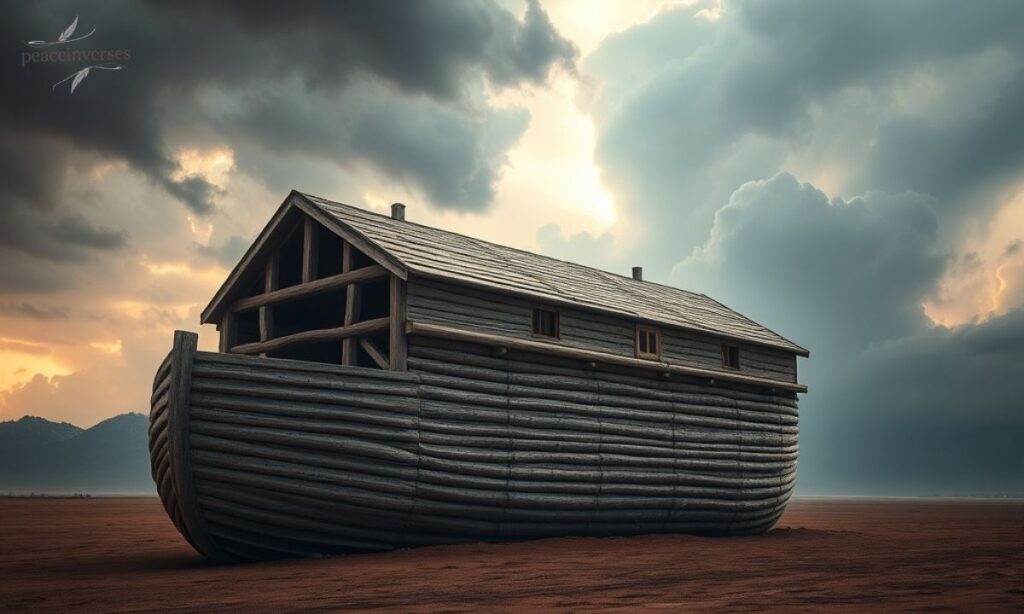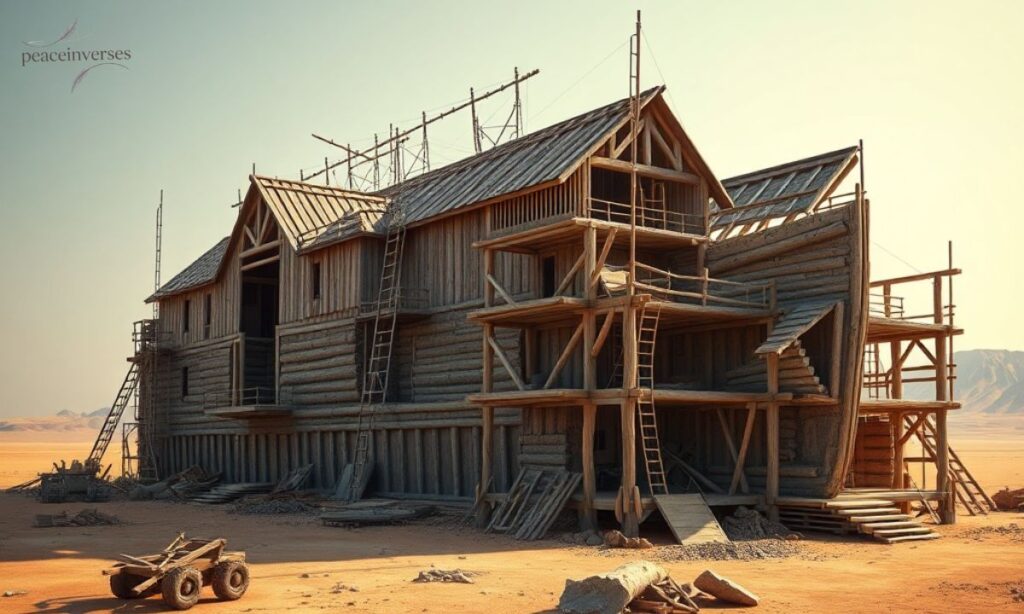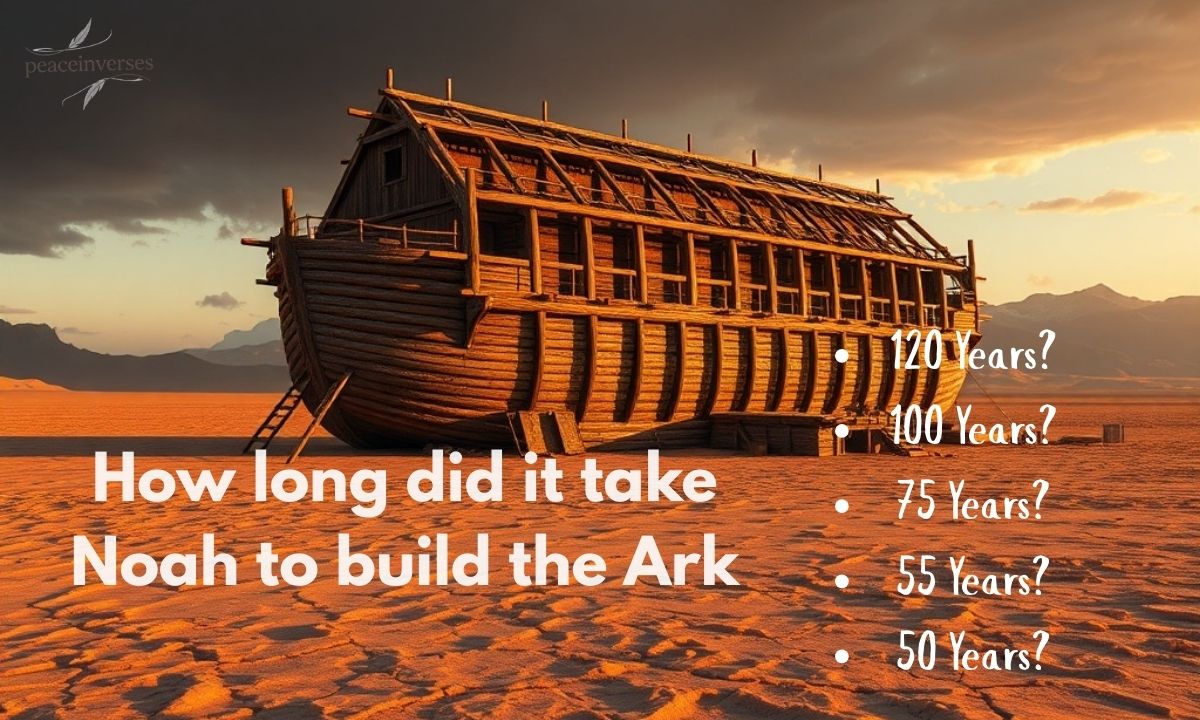Have you ever wondered how long it really took Noah to build the Ark? Many people quickly answer 120 years, but the Bible tells a deeper story. The truth is filled with mystery, faith, and lessons that go far beyond the timeline of construction.
The story behind Noah’s Ark is not just about building a giant boat—it’s about obedience and trust in God. While scholars debate whether it took 120, 100, or even 75 years, what stands out most is Noah’s faithfulness. His journey reminds us that when God gives a command, His timing and purpose are always perfect.
Who Was Noah in the Bible?
Noah was a righteous man who stood out in a world filled with corruption. The Bible says, “Noah was a righteous man, blameless among the people of his time, and he walked faithfully with God” (Genesis 6:9). His life was marked by obedience and trust in God.
When the earth was overflowing with violence and sin, Noah found favor in God’s eyes. Unlike others, he lived differently and chose the path of holiness. This shows us that one person’s faith can shine in the darkest times.
Noah’s story is not just about survival, but about faithfulness and obedience. His example reminds us that walking with God means standing apart from the world. Even when mocked, he stayed faithful.
God used Noah as a vessel of salvation for humanity and animals. Through his obedience, God’s plan unfolded to preserve life and show His mercy, even in the midst of judgment.
Why Did God Command Noah to Build the Ark?
The earth had become full of wickedness and violence, and God saw that man’s heart was evil. The Bible says, “The LORD saw how great the wickedness of the human race had become on the earth” (Genesis 6:5). Because of this, judgment was certain.
God’s command to Noah was both a warning and an act of mercy. By building the Ark, Noah was preparing a place of refuge and salvation for his family and the animals. It was a sign that God provides a way of escape.
The Ark was not only a physical structure but also a symbol of God’s grace. Just as Noah entered the Ark for safety, today we enter into Christ for salvation. “The Lord knows how to rescue the godly from trials” (2 Peter 2:9).
Through Noah, God demonstrated His justice and His mercy. He punished sin through the flood but saved Noah through the Ark. This balance reminds us of God’s holiness and His loving plan of redemption.
Common Misconceptions About the 120 Years

Many people believe it took Noah 120 years to build the Ark. This idea comes from “My Spirit shall not strive with man forever, for he is indeed flesh; yet his days shall be one hundred and twenty years” (Genesis 6:3). But this verse is not about the Ark.
Most scholars see this as referring to the lifespan of humans after the flood. It was not a countdown to how long Noah had to build. Misunderstanding this verse has led to confusion for many years.
Another misconception is that Noah worked completely alone. The Bible does not say this. His sons likely helped, and it’s possible that others assisted, even if they didn’t believe his warnings. Faithful obedience does not mean isolation.
The truth is that Noah may have had 75 years or less to complete the Ark. What matters most is not the exact years, but his unwavering obedience to God. His faith is what preserved his family and fulfilled God’s plan.
Did It Really Take 100 Years to Build the Ark?
Some people teach that Noah spent 100 years building the Ark. This idea comes from comparing Noah’s age. The Bible says, “After Noah was 500 years old, he became the father of Shem, Ham, and Japheth” (Genesis 5:32). Later, it says Noah was 600 years old when the flood came (Genesis 7:6).
From these verses, many assume that the 100 years between these ages equals the time Noah spent building. But the Bible never directly says that he started building when his sons were born. It only shows the time gap.
A closer look shows that Noah’s sons were already grown and married when God commanded him to build the Ark. “But I will establish my covenant with you, and you shall go into the Ark—you, your sons, your wife, and your sons’ wives with you” (Genesis 6:18). This means the building began later.
So, while 100 years is a common view, it does not have strong biblical support. Instead, the text suggests a shorter time frame, reminding us to always read carefully and not add where Scripture is silent.
The 75-Year Estimate Explained
Another perspective is that Noah had about 75 years at most to build the Ark. This idea comes from piecing together ages, marriages, and timelines. If Noah’s youngest son, Ham, married around Noah’s age of 525, then the building time was much shorter.
This means that the command to build the Ark came after the sons were grown and married. That would leave only about 75 years until the flood began at Noah’s age of 600.
It’s also possible the time was even less. If his sons married later, maybe closer to 65 years of age, Noah may have had only 30 to 50 years. This shows us that the Ark could have been completed much faster.
The lesson here is that obedience is not measured by time, but by faith. “By faith Noah, when warned about things not yet seen, in holy fear built an Ark to save his family” (Hebrews 11:7). Noah trusted God and worked with urgency.
Other Theories About the Ark’s Construction Timeline

Throughout history, different traditions have given different numbers. Some Jewish writings claim it took 52 years, while others even say as little as five years with God’s help. These views highlight how much people wonder about this story.
Some also suggest that Noah may have worked faster because of divine guidance or the help of many workers. The Bible doesn’t say how many hands were involved, but it’s likely Noah didn’t work entirely alone.
Skeptics sometimes argue that building such a large vessel was impossible with ancient tools. Yet, Scripture shows that people already knew how to use metal tools. “Tubal-Cain forged all kinds of tools out of bronze and iron” (Genesis 4:22).
The Ark Encounter, a modern replica, was built in just over two years with machines and crews. If Noah had decades, skilled workers, and God’s direction, the building timeline becomes far more believable.
How Long Did It Actually Take Noah to Build the Ark?
The exact number of years is not written in the Bible. What we know is that Noah had less than 100 years, and perhaps only 30 to 75 years. The popular 120 years is not correct, since it refers to human lifespan, not Ark construction.
Looking at the evidence, the most likely maximum is 75 years, but it could have been much less. Noah’s faithfulness, not the number of years, is the central message.
God’s command was clear, and Noah obeyed. “So Noah did everything just as God commanded him” (Genesis 6:22). His obedience saved his family and preserved life on earth.
So, we may never know the exact timeline, the story reminds us that God’s word is trustworthy. What matters most is not how many years it took, but that Noah obeyed, and God fulfilled His promise.
The Journey of the Ark During the Flood
When the flood came, the Bible says, “All the springs of the great deep burst forth, and the floodgates of the heavens were opened” (Genesis 7:11). Rain fell for forty days and nights, and the Ark began its journey over the waters.
The Ark floated above a world covered in judgment. “The waters rose and covered the mountains to a depth of more than twenty feet” (Genesis 7:20). Everything outside the Ark perished, but inside, there was life and safety.
For 150 days the waters remained powerful upon the earth. Yet the Ark did not sink or drift away. God’s hand preserved Noah, his family, and the animals as they waited in faith.
Finally, “the Ark came to rest on the mountains of Ararat” (Genesis 8:4). This marked the beginning of hope and renewal, showing God’s faithfulness to His promise of deliverance.
God’s Covenant with Noah After the Flood

After the floodwaters receded, Noah built an altar to the Lord. He offered sacrifices in thanksgiving, and God accepted them. “The LORD smelled the pleasing aroma and said in His heart: ‘Never again will I curse the ground because of humans’” (Genesis 8:21).
God then blessed Noah and his sons, saying, “Be fruitful and increase in number and fill the earth” (Genesis 9:1). This echoed the same command given to Adam, showing a new beginning for humanity.
The most powerful sign of this covenant was the rainbow. God said, “I have set my rainbow in the clouds, and it will be the sign of the covenant between me and the earth” (Genesis 9:13). It became a symbol of His mercy.
Through this covenant, God promised never again to destroy all life by a flood. It showed His justice but also His endless grace and faithfulness toward creation.
Lessons We Can Learn from Noah’s Obedience
Noah teaches us the value of faithful obedience. “By faith Noah… built an Ark to save his family” (Hebrews 11:7). Even when he couldn’t see the flood, he trusted God’s word completely.
Another lesson is patience in God’s timing. Noah built and waited for years before the flood came. His example reminds us to keep believing, even when God’s promises take time.
We also learn that obedience brings protection and blessing. Because Noah followed God’s instructions, his family was saved. This shows us that trusting God’s commands leads to life.
Finally, Noah’s story points us to Jesus Christ, our true Ark of salvation. Just as Noah entered the Ark to be saved from judgment, we must enter into Christ to receive eternal life.
Conclusion
The story of Noah and the Ark is more than a historical event—it is a testimony of faith, obedience, and God’s mercy. Noah’s journey shows us that even in times of judgment, God always provides a way of salvation for those who trust Him.
From the building of the Ark to the covenant of the rainbow, every detail reminds us of God’s faithfulness and grace. Just as Noah found safety in the Ark, we find eternal hope in Christ, who is our true refuge and promise of life.

